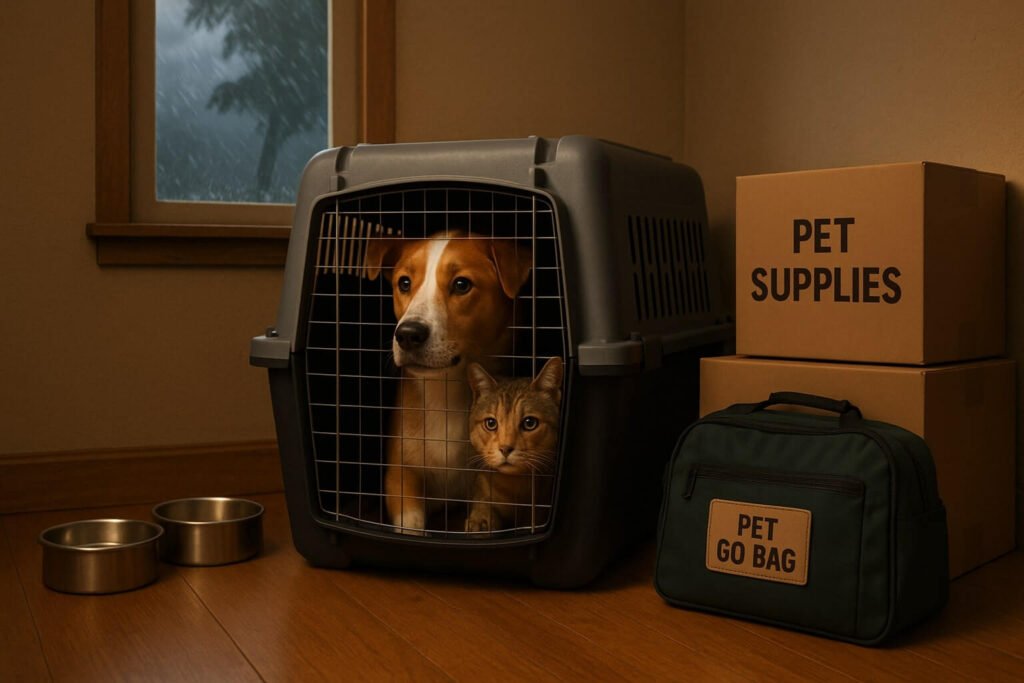I still remember the way my dog paced in circles before Hurricane Fiona hit. Animals know—long before we do. The air changes, the house feels still, and their instincts start buzzing. That night, I realised I wasn’t ready. I had my own things packed, a plan to get out… but for my dog? Nothing. I promised myself then: never again.
If you’re reading this before a storm, you’re already doing the right thing. Below are the five core things every pet owner should do for Pet Safety During a hurricane—because when chaos hits, preparation is the one thing you can control.
1. Create a Pet Go-Bag (With More Than Just Food)
Most people pack for two or three days. But in reality? You’ll need at least a week’s worth of supplies. Here’s what your pet’s hurricane kit should include:
- 7 days of food and bottled water
- Any meds your pet needs (at least 2 weeks’ supply)
- Printed vaccination records and vet contact info
- Leash, harness, collar with updated ID tags
- Portable bowls and waste bags
- A sturdy carrier or crate for each pet
- Comfort items: blanket, toy, or something that smells like home
- A current photo of you with your pet (for ID if you get separated)
If your pet needs medication regularly (like insulin or heart meds), label it clearly and keep it in a waterproof container. Add a note with dosage instructions, just in case someone else ends up caring for them temporarily.
2. Update Their ID—Yes, Even the Microchip
Microchips are only useful if your contact info is up to date. That means checking the registry before hurricane season. Also, attach a collar with a visible tag that has your mobile number and, ideally, a backup contact outside your area.
In a storm, power and internet often go down, which means animal control workers might not be able to scan microchips right away. A tag they can read on the spot might be your pet’s only ticket home.
I also recommend uploading a photo of your pet (plus one of you together) to cloud storage. If your phone is lost or water-damaged, you’ll still have proof of ownership.
3. Have a Pet-Friendly Evacuation Plan
Pet Safety During hurricanes doesn’t just mean keeping them safe if you stay home. You also need a plan for if you have to leave—and that means knowing where your pet is welcome.
- Check which shelters allow pets (many don’t unless they’re service animals)
- Book a pet-friendly hotel now—don’t wait until everyone’s scrambling
- Print driving directions—flooding may make GPS unreliable
- Ask a neighbor or friend to be a backup contact in case you’re away when orders hit
Don’t assume you’ll have time to figure this out last-minute. One of my friends had to sleep in her car with two cats during a storm because no hotel would take them, and the shelter had turned them away. It’s not something you want to risk.
4. Make a Safe Room—Windowless, Quiet, Dry
If you’re riding the storm out at home, designate a safe, secure space inside your house. Ideally, this should be:
- Windowless (bathroom or hallway closets work best)
- Far from exterior doors
- Stocked with bedding, litter box, food, and water
- Cleaned of hazards like bleach, sharp tools, or hanging cords
Line the floor with towels or pee pads. Put crates on top of a thick blanket in case water seeps in. If you can, keep a battery-powered lantern—not candles.
During Hurricane Ian, I had to block a draft under the bathroom door with a rolled-up beach towel to stop water from blowing in sideways. Small things like that make a huge difference.
5. Practice, Don’t Panic—Run Drills
Your pet won’t magically know what’s happening during a real emergency. Practice helps.
- Try loading your pet into their carrier quickly
- Drive the evacuation route once or twice
- Keep a leash clipped inside the carrier so it’s always ready
- Play calming music and give treats during drills so the routine feels positive
Also, sign up for local storm alerts and keep a radio with fresh batteries nearby. Hurricanes can knock out power for days, and staying informed can save both your life and theirs.
And if you haven’t already—talk to your vet. Ask what shots are important (some shelters won’t take unvaccinated animals), and double-check you’ve got enough meds to get through at least two weeks.
After the Storm: Watch Closely
Just because the storm has passed doesn’t mean the danger is over.
- Let pets out on leash only at first—downed power lines, debris, and contaminated water are serious risks
- Toss out any food that got wet—mold toxins form fast
- Watch for signs of trauma: hiding, growling, or sudden aggression
Even the calmest pets can panic in unfamiliar surroundings. Be patient. Give them space, quiet, and comfort.
The Quiet Promise Behind All This
Planning for Pet Safety During a hurricane is really about love. It’s about promising your dog, your cat, your rabbit, or your parakeet: I will not leave you behind. You don’t need to be perfect. You just need to be ready.
Label your kit. Map your route. Run that drill. Because if the storm comes—and one day, it will—you’ll be able to look your pet in the eye and say, “We’ve got this.”


